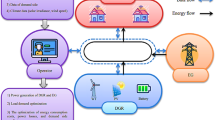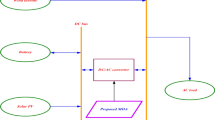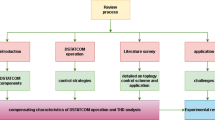Abstract
Energy optimization is one of the major issues for electrical distribution companies to meet demand with minimum generation costs and power losses. In this paper, the optimal operation of the smart electrical distribution grid is modeled by three-stage multi-objective optimization with optimal consumers’ participation and electrical storage systems (ESSs) under electrical price and load demand uncertainties at day ahead. The three strategies of demand response programs (DRPs) such as demand shifting (DS), demand curtailment (DC), and onsite generation (OG) to consumers’ participation are considered with attention to electrical price traffic. In the first and second stages, electrical demand is optimized using DS and DC strategies, respectively. Thus, optimized electrical demand is applied to the third stage optimization for minimization of the multi-objective functions including (1) minimum generation costs and (2) power losses. Also, OG is implemented by ESSs in the third stage optimization as a local resource. All stages of the proposed approach are optimized by the shuffled frog leaping (SFL) algorithm. On the other side, the TOPSIS decision-making method is used to choose the best trade-off solution in the third stage optimization. Eventually, the proposed optimization by the numerical simulation is carried out considering four case studies in IEEE 33-bus test system to demonstrate validation of the strategies. The case studies are implemented based on the participation of the consumers by using DS, DC, and OG strategies. In the first case study, the participation of the consumers is not considered, and this case is assumed as a base case study. The participation of the consumers with the DS strategy is implemented in the second case study. The DS and DC strategies are used by consumers in the third case study, simultaneously. In the fourth case study, OG with DS and DC strategies is considered for optimal participation in energy optimization. The participation of all strategies by consumers leads to minimizing energy generation costs and power loss by 5.52% and 14.68% in comparison with non-participation of the consumers.











Similar content being viewed by others
Availability of data and materials
The data that support the findings of this study are available from the corresponding author upon reasonable request.
Abbreviations
- DC:
-
Demand curtailment
- DRPs:
-
Demand response programs
- DG:
-
Diesel generator
- DS:
-
Demand shifting
- ESS:
-
Electrical storage system
- TOPSIS:
-
Technique for order of preference by similarity to ideal solution
- OG:
-
Onsite generation
- \(t,T\) :
-
Time index
- \(d,D\) :
-
Diesel generator (DG) index
- \({\text{DS}},{\text{DS}}\) :
-
Index of consumers with demand shifting (DS) strategy
- \({\text{dc}},{\text{DC}}\) :
-
Index of consumers with demand curtailing (DC) strategy
- \({{\text{OG}}},{{\text{OG}}}\) :
-
Index of the consumers with onsite generation (OG) strategy
- \({{\text{EM}}}\) :
-
Electrical market index
- \(i,j,\Lambda\) :
-
Bus indices
- \(s,S\) :
-
Scenario indices
- \(\alpha ,\beta ,\lambda\) :
-
Fuel cost factors of DGs
- \(\pi_{{{\text{EP}}}}\) :
-
Electrical price in electrical market
- \({\text{ED}}_{{{\text{DS}}}}\) :
-
Active power demand of the consumers with demand shifting (DS) strategy
- \({\text{ED}}_{{{\text{DC}}}}\) :
-
Active power demand of the consumers with demand curtailing (DC) strategy
- \({\text{ED}}_{{{{\text{OG}}}}}\) :
-
Active power demand of the consumers with onsite generation (OG) strategy
- \({\text{ED}}_{{{\text{DS}}}}^{{{\text{OP}}}}\) :
-
Optimized active power demand of the consumers with demand shifting (DS) strategy
- \({\text{ED}}_{{{\text{DC}}}}^{{{\text{OP}}}}\) :
-
Optimized active power demand of the consumers with demand curtailing (DC) strategy
- \({\text{QD}}_{{{\text{DS}}}}^{{{\text{OP}}}}\) :
-
Optimized reactive power demand of the consumers with demand shifting (DS) strategy
- \({\text{QD}}_{{{\text{DC}}}}^{{{\text{OP}}}}\) :
-
Optimized reactive power demand of the consumers with demand curtailing (DC) strategy
- \({\text{QD}}_{{{{\text{OG}}}}}\) :
-
Reactive power demand of the consumers with onsite generation (OG) strategy
- \(\Upsilon_{{{\text{DS}}}}\) :
-
Participation rate of the consumers with demand shifting (DS) strategy
- \(\Upsilon_{{{\text{DC}}}}\) :
-
Participation rate of the consumers with demand curtailing (DC) strategy
- \(P_{{{{\text{OG}}}}}^{{r,{{\text{ess}}}}}\) :
-
Power rate of the ESS for consumers with onsite generation (OG) strategy
- \({\text{RU}},{\text{RD}}\) :
-
Ramp up and ramp down of DGs
- \(\eta^{dch} ,\eta^{ch}\) :
-
Efficiency of ESS in discharge and charge modes, respectively
- \(r_{\Lambda }\) :
-
Resistance of the branch between buses i and j
- \(C_{d}\) :
-
Generation cost of DGs
- \(C_{{{{\text{EM}}}}}\) :
-
Generation cost of the electrical market
- \({\text{ED}}_{{{\text{DS}}}} (s,t,t^{^{\prime}} )\) :
-
Amount of the electrical demand shifted by consumers with demand shifting (DS) strategy
- \(P_{d}\) :
-
Active power generated by DG
- \(P_{{{{\text{EM}}}}}\) :
-
Active power generated by electrical market
- \(P_{{{\text{loss}}}}\) :
-
Active power losses
- \(Q_{d}\) :
-
Reactive power generated by DG
- \(Q_{{{{\text{EM}}}}}\) :
-
Reactive power generated by electrical market
- \(Q_{{{\text{loss}}}}\) :
-
Reactive power losses
- \(P_{\Lambda }\) :
-
Active power flow between buses i and j
- \(Q_{\Lambda }\) :
-
Reactive power flow between buses i and j
- \(V_{\Lambda }\) :
-
Voltage value in buses i and j
- \(P_{{{{\text{OG}}}}}^{{ch,{{\text{ess}}}}}\) :
-
Power charged by ESS in onsite generation (OG) strategy
- \(P_{{{{\text{OG}}}}}^{{dch,{{\text{ess}}}}}\) :
-
Power discharged by ESS in onsite generation (OG) strategy
- \(\Omega_{{{{\text{OG}}}}}\) :
-
Available energy of ESS in onsite generation (OG) strategy
- \(u_{{{{\text{OG}}}}}\) :
-
Binary variable of the ESS in onsite generation (OG) program (1 = discharge mode and 0 = Otherwise)
- \(\rho_{s}^{{}}\) :
-
Probability of scenario s
- \(\rho_{s}^{L,\Theta }\) :
-
Probability of load demand and electrical price in scenario s
References
Momoh J (2019) Smart grids: fundamentals of design and analysis. Wiley-IEEE Press
Padmanaban S, Samavat T, Nasab MA, Nasab MA, Zand M, Nikokar F (2023) Electric vehicles and IoT in smart cities. Artif Intelligence-based Smart Power Syst. https://doi.org/10.1002/9781119893998.ch14
Zhang X, Hug G, Kolter JZ, Harjunkoski I (2018) Demand response of ancillary service from industrial loads coordinated with energy storage. IEEE Trans Power Syst 33(1):951–961
Li Y, Yang Z, Li G, Zhao D, Tian W (2019) Optimal scheduling of an isolated microgrid with battery storage considering load and renewable generation uncertainties”. IEEE Trans Ind Electron 66(2):1565–1575
Khalili M, Dashtaki MA, Nasab MA, Hanif HR, Padmanaban S, Khan B, Meng W (2022) Optimal instantaneous prediction of voltage instability due to transient faults in power networks taking into account the dynamic effect of generators. Cogent Eng 9:1. https://doi.org/10.1080/23311916.2022.2072568
Wang Y et al (2018) Energy management of smart micro-grid with response loads and distributed generation considering demand response. J Clean Prod 197(1):1069–1083
Dashtaki AA, Khaki M, Zand M, Nasab MA, Sanjeevikumar P, Samavat T, Nasab MA, Khan B (2022) A day ahead electrical appliance planning of residential units in a smart home network using ITS-BF algorithm. Int Trans Electr Energy Syst 2022:2549887. https://doi.org/10.1155/2022/2549887
Ren J et al (2018) Joint load scheduling and voltage regulation in distribution system with renewable generators”. IEEE Trans Ind Inf 14(4):1564–1574
Zamanloo S et al (August 2021) Optimal two-level active and reactive energy management of residential appliances in smart homes. Sustain Cities Soc 71:102972
Sibuea MB, Sibuea SR, Pratama I (2021) The impact of renewable energy and economic development on environmental quality of ASEAN countries. AgBioforum 23(1):12–21
Wu Q et al (2022) Optimal trading strategies for multi-energy microgrid cluster considering demand response under different trading modes: a comparison study. Energy 254(Part C):124448
Mohseni S et al (2021) Modelling utility-aggregator-customer interactions in interruptible load programmes using non-cooperative game theory. Int J Electr Power Energy Syst 133:107183
Siano P (2014) Demand response and smart grids- a survey. Renew Sustain Energy Rev 30:461–478
Capper T et al (2022) Peer-to-peer, community self-consumption, and transactive energy: a systematic literature review of local energy market models. Renew Sustain Energy Rev 162:112403
Saboori H et al (2015) Reliability improvement in radial electrical distribution network by optimal planning of energy storage systems. Energy 93:2299–2312
Ismail AG et al (2020) Enhancement of electrical distribution networks performance using the load management methodology. Energy Rep 6:2066–2074
Tran TTD, Smith AD (2018) Thermoeconomic analysis of residential rooftop photovoltaic systems with integrated energy storage and resulting impacts on electrical distribution networks. Sustain Energy Technol Assess. 29:92–105
Fathy A et al (2021) Robust approach based chimp optimization algorithm for minimizing power loss of electrical distribution networks via allocating distributed generators. Sustain Energy Technol Assess 47:101359
Shaheen A et al (2022) Reconfiguration of electrical distribution network-based DG and capacitors allocations usingnartificial ecosystem optimizer: Practical case study. Alex Eng J 61:6105–6118
Gu C et al (2021) Joint planning of electrical storage and gas storage in power-gas distribution network considering high-penetration electric vehicle and gas vehicle. Appl Energy 301:117447
Janamala V, Reddy DS (2021) Coyote optimization algorithm for optimal allocation of interline Photovoltaic battery storage system in islanded electrical distribution network considering EV load penetration. J Energy Storage 41:102981
Edmonds L et al (2021) Coordinated operation of water and electricity distribution networks with variable renewable energy and distribution locational marginal pricing. Renew Energy 177:1438–1450
Monteiro RVA et al (2018) A medium-term analysis of the reduction in technical losses on distribution systems with variable demand using artificial neural networks: an electrical energy storage approach. Energy 164:1216–1228
Wang H et al (2019) Modelling of ampacity and temperature of MV cables in presence of harmonic currents due to EVs charging in electrical distribution networks. Int J Electr Power Energy Syst 112:127–136
Babanezhad M et al (2022) Reactive power based capacitors allocation in distribution network using mathematical remora optimization algorithm considering operation cost and loading conditions. Alex Eng J 61:10511–10526
Yang H et al (2020) Coordinated demand response of rail transit load and energy storage system considering driving comfort. CSEE J Power Energy Syst 6(4):749–759
Qi Qi et al (2017) Multi-objective operation optimization of an electrical distribution network with soft open point. Appl Energy 208:734–744
Xiaotong Xu et al (2019) Structural and hierarchical partitioning of virtual microgrids in power distribution network. IEEE Syst J 13:823–832
Asl DK et al (2020) Multi-objective optimal operation of integrated thermal-natural gaselectrical energy distribution systems. Appl Therm Eng 181:115951
Li H et al (2021) Cooperative voltage control in MV distribution networks with electric vehicle charging stations and photovoltaic DGs. IEEE Syst J 15:2989–3000
Luo Y et al (2021) Robust optimal operation of active distribution network based on minimum confidence interval of distributed energy beta distribution. J Modern Power Syst Clean Energy 9(2):423–430
Rayati M et al (2022) Distributionally robust chance constrained optimization for providing flexibility in an active distribution network. IEEE Trans Smart Grid 13(4):2920–2934
Khan R (2021) An optimization-based reliability enhancement scheme for active distribution systems utilizing electric vehicles. IEEE Access 9:157247–157258
Acosta JS et al (2019) Optimal multi-scenario, multi-objective allocation of fault indicators in electrical distribution systems using a mixed-integer linear programming model. IEEE Trans Smart Grid 10:4508–4519
Chamandoust H et al (2020) Tri-objective scheduling of residential smart electrical distribution grids with optimal joint of responsive loads with renewable energy sources. J Energy Storage 27:101112
Chamandoust H et al (2020) Multi-objective performance of smart hybrid energy system with multi-optimal participation of customers in day-ahead energy market. Energy Build 216:109964
Dolatabadi A et al (2019) Short-term scheduling strategy for wind-based energy hub: a hybrid stochastic/IGDT approach. IEEE Trans Sustain Energy 10:438–448
Babaei M, Azizi E, Beheshti MT, Hadian M (2020) Data-Driven load management of stand-alone residential buildings including renewable resources, energy storage system, and electric vehicle. J Energy Storage 28:101221
Chamandoust H et al (2022) Optimal hybrid participation of customers in a smart micro grid based on day ahead electrical market. Artif Intell Rev 55(7):5891–5915
Jafarian-Namin S, Goli A, Qolipour M, Mostafaeipour A, Golmohammadi A-M (2019) Forecasting the wind power generation using Box-Jenkins and hybrid artificial intelligence: a case study. Int J Energy Sect Manage 13(4):1038–1062
Chamandoust H et al (2021) Energy management of a smart autonomous electrical grid with a hydrogen storage system. Int J Hydrog Energy 46(34):17608–17626
Zand M et al (2020) Using adaptive fuzzy logic for intelligent energy management in hybrid vehicles. In: 2020 28th Iranian conference on electrical engineering (ICEE)
Eusuff MM, Lansey K, Pasha F (2006) Shuffled frog leaping algorithm: a memetic meta-heuristic for discrete optimization. J Eng Optim 38:129–154
Alghazi A, Selim SZ, Elazouni A (2012) Performance of shuffled frog-leaping algorithm in finance-based scheduling. J Comput Civ Eng 26:396–408
Sayyaadi H et al (2012) Efficiency enhancement of a gas turbine cycle using an optimized tubular recuperative heat exchanger. Energy 38:362–375
Zhao F, Zhang C, Sun B (2016) Initiative optimization operation strategy and multi-objective energy management method for combined cooling heating and power. IEEE/CAA J Autom Sin 3:385–393
Dharageshwari K, Nayanatara C (2015) Multiobjective optimal placement of multiple distributed generations in IEEE 33 bus radial system using simulated annealing. In: 2015 International conference on circuits, power and computing technologies [ICCPCT-2015], IEEE, pp 1–7
Chamandoust H et al (2018) Scheduling of smart micro grid considering reserve and demand side management. In: IEEE smart grid conference, pp 1–10
Chamandoust H (2018) Economic scheduling of microgrid based on energy management and demand response. Electr Control Commun Eng 14(2):100–107
Nazari-Heris M, Abapour S, Mohammadi-Ivatloo B (2017) Optimal economic dispatch of FC-CHP based heat and power micro-grids. Appl Therm Eng 114:756–769
Aghaei J, Alizadeh M-I (2013) Multi-objective self-scheduling of CHP (combined heat and power)-based microgrids considering demand response programs and ESSs (energy storage systems). Energy 55:1044–1054
Mirjalili S, Lewis A (2015) Novel performance metrics for robust multi-objective optimization algorithms. Swarm Evol Comput 21:1–23
Zitzler E (1999) Evolutionary algorithms for multiobjective optimization: methods and applications, vol 63. Shaker, Ithaca
Yen GG et al (2014) Performance metrics ensemble for multi-objective evolutionary algorithms. IEEE Trans Evol Comput 18(1):131–144
Funding
There are no funding sources.
Author information
Authors and Affiliations
Contributions
All authors have equal contributions including conceptualization, methodology, software, data curation, formal analysis, writing—review and editing, and writing—original draft.
Corresponding author
Ethics declarations
Conflict of interest
The authors declare that they have no known competing financial interests or personal relationships that could have appeared to influence the work reported in this paper.
Ethical approval
There are no human subjects in this manuscript, and informed consent is not applicable.
Additional information
Publisher's Note
Springer Nature remains neutral with regard to jurisdictional claims in published maps and institutional affiliations.
Rights and permissions
Springer Nature or its licensor (e.g. a society or other partner) holds exclusive rights to this article under a publishing agreement with the author(s) or other rightsholder(s); author self-archiving of the accepted manuscript version of this article is solely governed by the terms of such publishing agreement and applicable law.
About this article
Cite this article
Montaghami, V., Rezvani, M., Yousefi, B. et al. Techno-economic optimal operation of the electrical distribution grid considering smart energy consumption by consumers. Electr Eng 105, 2653–2673 (2023). https://doi.org/10.1007/s00202-023-01845-z
Received:
Accepted:
Published:
Issue Date:
DOI: https://doi.org/10.1007/s00202-023-01845-z




